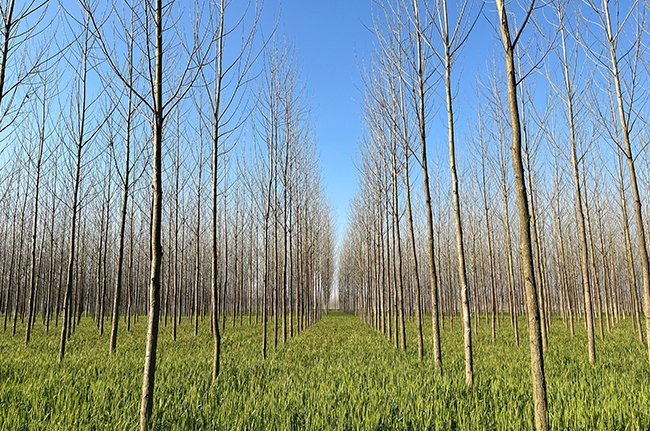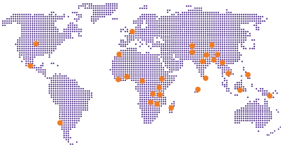Catalyzing Green Economies: The TOFI Program and the Role of Tree-Based Enterprises (TBEs) through Trees Outside Forests in India

Situation/Challenge
India’s rapidly growing economy and population have placed increasing pressure on natural resources, especially wood. Despite having a strong forestry sector, the country faces a significant deficit in wood supply, with more than 50% of its annual demand met through imports. This reliance on foreign sources presents economic, environmental, and strategic vulnerabilities. At the same time, India is committed to ambitious climate and biodiversity goals, including its Nationally Determined Contributions (NDCs) under the Paris Agreement, the Bonn Challenge, and the Sustainable Development Goals (SDGs).
A key, often overlooked, solution lies outside India’s traditional forests. Trees Outside Forests (ToF)trees grown on private farmlands, community lands, and degraded landscapesare a critical yet underutilized resource. These tree systems provide wood, fuel, food, and fodder, while also offering climate resilience, biodiversity support, and livelihood opportunities. However, a combination of policy, economic, and informational barriers has stifled the growth of this promising sector.
Introducing TOFI: A Pioneering Approach:
To address this multifaceted challenge, the Trees Outside Forests in India (TOFI) program was launched by USAID, in partnership with the Ministry of Environment, Forest and Climate Change (MoEFCC), and implemented by a consortium led by CIFORICRAF (Center for International Forestry Research and World Agroforestry).
TOFI is not merely a treeplanting initiative. It is a systemic intervention aimed at transforming how trees outside forests are perceived, governed, and integrated into the rural economy. The program spans seven diverse statesRajasthan, Haryana, Odisha, Andhra Pradesh, Tamil Nadu, Assam, and Uttar Pradeshchosen for their varying Agroclimatic conditions, market potential, and socioeconomic contexts.
The core goal of TOFI is to create a robust ecosystem for expanding ToF by addressing policy bottlenecks, building institutional and community capacity, enhancing access to information and finance, and developing viable treebased enterprises (TBEs) across the value chain.
Challenges and Barriers to Growth:
Several persistent challenges have prevented the mainstreaming of ToFI systems in India.
- Long Gestation and Uncertain Markets: One of the most pressing issues is the long gestation of tree crops and uncertainty on price movements for the final produce. This creates a supplydemand mismatch in the wood market. Fluctuations in prices have historically led to distrust among stakeholdersfarmers often uproot trees during price crashes, while industries hesitate to scale up due to uncertain supply.
- Regulatory and Policy Barriers: The wood and other products obtained from trees are largely governed under strict forest regulations like Indian Forest Act,1927 which places severe restrictions on harvesting and transit of these products, even if they originate in nonforest areas. Besides, forests are a concurrent subject on the 42nd amendment of constitution and accordingly separate regulations apply on interstate trade allowing corrupt market practices to take root.
- Lack of coordination: Another significant barrier is the information asymmetry between producers, buyers, and policymakers. The absence of a centralized, transparent platform has led to fragmented value chains and inefficient policy implementation. Moreover, statespecific issues further complicate matters. For instance, Odisha grapples with low productivity in its cashew industry, while Agar is Assam follows a monopsonistic market practice with limited reward for growers. Likewise, Haryana has seen a decline in wood trade in major hubs like Yamuna Nagar, affecting local economies and market dynamics.
Focus on TreeBased Enterprises (TBEs):
Central to the TOFI strategy is the promotion of TreeBased Enterprises (TBEs)business ventures that depend on or support the ToFI ecosystem. These include sectors such as plywood, pulp, furniture, engineered wood, pharmaceuticals, and food processing.
The program identifies TBEs as a lever for inclusive green growth, offering a winwin for both the environment and rural livelihoods. TOFI’s research and field assessments have focused on three enterprise scales:
Large enterprises: Typically located in or near industrial corridors and cities, these include major wood processors and exporters.
Micro, Small, and Medium Enterprises (MSMEs): Spread across semiurban and rural landscapes, MSMEs serve both local and national markets.
Communityled enterprises: Often informal and grassroots in nature, these include selfhelp groups and farmer collectives producing nontimber forest products, local crafts, or nursery materials.
Intellecap joined the TOFI initiative as a strategic partner, leveraging its specialized knowledge in sustainable development, stakeholder collaboration, and creating inclusive ecosystems. The program was executed by CIFORICRAF, where Intellecap took on critical responsibilities in conducting research, formulating strategies, and aligning stakeholders’ interests.
Solution
This engagement reaffirms Intellecap’s ability to build ‘future ready’ solutions that support transformative business ideas and create sustainable impact agroforestrybased communities.
Intellecap, through its natural resource solutions advisory, continues to create tailored strategies, scalable models, reducing carbon emissions whilst generating employment opportunities. By working closely with State Govts. and Global Development Institutions we are building ecosystems through systemic change.
The TOFI program is one such example where we have implemented a structured strategy to address India’s wood supply deficit and stabilize agroforestry value chains. The solution was tailored to each state’s unique challenges while maintaining an overarching framework for scalability.
- We conducted extensive consultations and Engaged 128+ stakeholders, including large to small scale industries, policymakers, traders, aggregators and growers to gather groundlevel insights.
- We Mapped approximately 200+ treebased enterprises to identify key bottlenecks in supply, processing, and market linkages.
- StateSpecific approaches were required to map value chains and identify critical gaps and provide targeted solutions based on its agroforestry. We Identified 21 TBEs across 7 states.
- Policy & Institutional Support: Advocated for MOEFCCled easing of regulatory frameworks to streamline tree felling and transportation laws. Also, proposed incentives for farmers (e.g., subsidies, insurance) to encourage agroforestry over traditional crops.
- Digital Platform for Price Transparency: A centralized dashboard to track demand, supply, and pricing trends was suggested.
- We identified the Critical Success Factors for the shortlisted TBEs and mapped out a clear long term Stakeholder Engagement
- We developed 7 Business Cases with detailed financial projections including Sensitivity analysis and futuristic cash flow projections, ensuring benefits for farmers, industries, and the environment. The Business Plan also consisted of Investment
- Cases for each shortlisted enterprise sector with a potential impact matrix and a roadmap.
Key Outcomes/ Impact
- Contextual recommendations for each state were,
- Cashew aggregation and processing through FPOs and existing cashew clusters in Odisha
- A digital platform to address Information Asymmetry in Haryana and setting up of a largescale Medium Density Fibre unit in Haryana. Waste biomass processing to biochar for potential carbon benefits.
- Setting up centralised processing centres for Agar oil in Assam
- A rentbased furniture ecommerce facility in Rajasthan
- A largescale Rayon Grade Pulp unit in Uttar Pradesh
- Decentralised pulp waste processing to produce Compressed Biogas (CBG) and Fermented Organic Manure (FOM) in Tamil Nadu
- A Neem Seed Kernel Extract (NSKE) facility in Andhra
- Economic potential to generate over $10 billion in revenue by bridging gaps between stakeholders.
- Scalable models, including FPOs and financing facilities, to ensure longterm sustainability.
- Reduction in annual carbon emissions by over 3.2 Million tCO2e through new plantations, initiatives like biochar and methane reduction in CBG.
- Traceability systems and certified planting material may increase export compliance by 60%.
- 700,000+ hectares of new plantations established across seven states, and will include wastelands and various species like poplar, eucalyptus, and horticulture crops.
- Potential revenue generation of ₹17,000 crore annually from treebased enterprises.
- Employment opportunities to benefit more than 87,000 new job creation apart from benefitting more than 300,000 farmers across the seven States, amounting to 2 million persondays of work.
Key Takeaways
- Holistic Stakeholder Involvement: Engaging farmers, industries, and policymakers is critical to aligning incentives and ensuring program success.
- Localized Solutions: A onesizefitsall approach does not work; solutions must address statespecific challenges.
- Digital Platforms: Information asymmetry can be mitigated through technology, fostering trust and stability in the ecosystem.
- Scalability: Models like FPOs and financing facilities can be replicated across other regions and sectors.
- Economic and Environmental Synergy: The program demonstrated how economic growth (e.g., reviving industries) can coexist with environmental benefits (e.g., increasing green cover).




